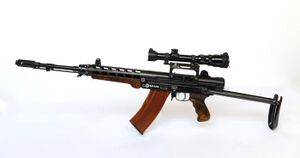Engineering:VAHAN (firearm)
| VAHAN | |
|---|---|
 The VAHAN assault rifle | |
| Type | Assault rifle |
| Place of origin | Soviet Union, Armenia |
| Production history | |
| Designer | Vahan S. Manasian |
| Designed | 1952–54, 1992 |
| Specifications | |
| Mass | 3.85kg |
| Length | 920mm (725mm folded) |
| Cartridge | 5.45×39mm |
| Calibre | 5.45mm |
| Action | Lever-delayed blowback |
| Rate of fire | 800 RPM |
| Effective firing range | 500m–1000m |
| Feed system | 30/45-round detachable box magazine |
| Sights | Iron sights |
The VAHAN is an assault rifle of Soviet/Armenian origin and was designed by Engineer and Firearms Designer Vahan S. Manasian. It can be fitted with a GP-30 grenade launcher, bayonet and scope. The weapon dates back to 1952 as the MBC-2 when Manasian was a soldier in the Soviet Army. As of 2009, The VAHAN rifle has not yet been tested by Armenian Government.
Overview
The rifle uses stamped upper and lower assemblies held together by a pin at the front and a button at the rear. Depressing the button allows the two main assemblies to separate so the bolt can be removed and the internal parts accessed. The safety is a lever located inside the trigger guard, which both blocks the firing mechanism and locks the bolt in the forward position when flipped down. The trigger mechanism is the type popular in some submachine guns, where a partial pull will fire single shots and a complete pull will fire full auto.
Sights consist of a two position rear aperture and front post, both with decent protective wings. There is also a Russian style scope rail fixed to the left side of the receiver to allow mounting of an optical sight.
The lever delayed blowback operation is a good one, with the understanding that it tends to be pretty sensitive to the specific pressure curve of the ammo it’s designed for. Change the bullet weight or powder type, and it may not work so well anymore (see: FAMAS). The position of the scope looks shoddy, and the underfolding stock is one of the least comfortable designs of folding stock ever devised.
Lever delayed blowback assault rifles were tested by Soviet army on numerous occasions, and despite their merits (simplicity, low cost, reduced felt recoil) these were found generally less reliable than gas operated actions, especially when considering variety of loadings, case materials and coatings, and performance under harsh conditions.
See also
External links

